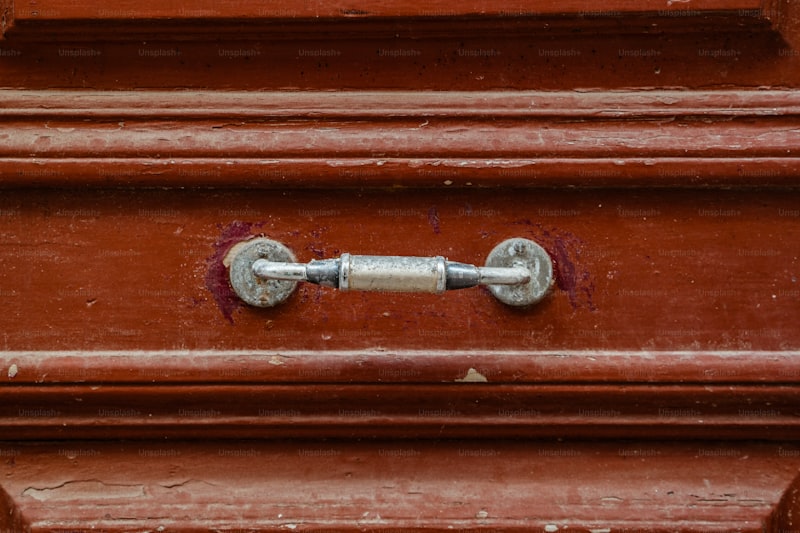So, what causes these pesky door hinge issues? Most often, it’s simply due to prolonged use and exposure to the elements. As your car ages, the hinges can become worn out, rusty, or even misaligned. These issues can affect the smooth operation of your doors, making them difficult to open or close smoothly.
The good news is that repairing door hinge issues doesn’t always require a trip to the mechanic. With a bit of know-how and the right tools, you can often tackle this problem yourself. Here’s how:
-
Diagnose the Problem: Start by examining the door hinges closely. Look for signs of rust, visible damage, or misalignment. Sometimes, simply tightening loose bolts or screws can solve the problem.
-
Gather Your Tools: To fix the issue, you’ll typically need a socket wrench set, lubricating oil, a screwdriver, and perhaps some sandpaper if rust is an issue.
-
Lubricate the Hinges: Apply lubricating oil generously to the hinges and the surrounding mechanisms. This helps to reduce friction and smooth out the door’s operation. Remember, a well-lubricated hinge is a happy hinge!
-
Tighten Loose Parts: Check for any loose bolts or screws on the hinge and door frame. Tighten them carefully to ensure a secure fit.
-
Address Rust: If rust is present, gently sand the affected areas and apply a rust inhibitor. This prevents further corrosion and keeps your hinges in good shape.
-
Test the Door: After making adjustments and repairs, test the door to ensure it opens and closes smoothly without any squeaks or resistance.

By taking these steps, you can often resolve minor door hinge issues on your own, saving time and money. However, if the problem persists or if you’re uncomfortable tackling it yourself, it’s always best to consult a professional mechanic. They have the expertise and tools to handle more complex hinge repairs or replacements.
Remember, maintaining your car’s hinges is key to ensuring a hassle-free driving experience. With a little care and attention, you can keep those doors swinging smoothly for miles to come. So, next time you encounter a squeaky hinge or a stubborn door, don’t panic – you’ve got this!
Mastering Mechanics: Essential Steps to Fixing Car Door Hinge Problems
Firstly, identify the root cause. Is it the hinge itself, or could it be related to the door alignment? Sometimes, it’s as simple as debris or rust buildup causing the hinge to creak. Other times, wear and tear over the years might be the culprit.
Next, gather your tools. You’ll typically need a wrench or socket set, lubricating oil or grease, and possibly a screwdriver. Ensure you have everything handy before starting.
Begin by examining the hinge visibly. Look for any visible signs of damage or wear. Is there excessive rust, or are the hinges visibly misaligned? This visual inspection helps pinpoint where the problem lies.
Now, apply lubrication to the hinges. Lubricating the hinge pins and pivot points can often resolve minor issues like squeaking. Use a suitable lubricant recommended for automotive use to ensure smooth operation.
If the problem persists, tighten the bolts. Sometimes, loose bolts can cause the door to sag or not close properly. Carefully tighten each bolt on the hinges to the manufacturer’s recommended torque specifications.
For more severe issues such as a damaged hinge, consider replacement. While this is more involved, replacing a worn-out hinge can restore proper function to your car door.
By mastering these essential steps, you can effectively troubleshoot and fix car door hinge problems without the need for professional help in many cases. Remember, regular maintenance and prompt attention to minor issues can prevent larger, costlier problems down the road.
DIY Car Care: Simple Solutions for Sticky Door Hinges
Dealing with sticky door hinges on your car can be frustrating, but fear not—there are simple DIY solutions that can make a world of difference. When your car doors start creaking and resisting movement, it’s often due to dirt, grime, or lack of lubrication. Here’s how you can tackle this issue without needing professional help.
Firstly, assess the hinges for any visible dirt or debris. Sometimes, a simple cleaning with a rag and some gentle degreaser can do wonders. Make sure to wipe down both the door hinges and the surrounding areas to prevent future buildup.
Next, lubricate the hinges using a suitable lubricant like WD-40 or silicone spray. Apply a small amount directly onto the hinges and work the door back and forth to distribute the lubricant evenly. This helps reduce friction and eliminates that annoying squeak.
If your hinges are rusty, consider using a rust remover before lubricating. Rust can significantly hinder smooth door operation, so it’s essential to address it promptly. Once the rust is removed, proceed with lubrication as usual.
For persistent issues, such as severely rusted or damaged hinges, it might be necessary to replace them entirely. Consult your car manual or a professional mechanic for guidance on safely replacing car door hinges.
Regular maintenance is key to preventing sticky door hinges. Schedule periodic checks and cleaning sessions to keep your car doors operating smoothly. Remember, a little maintenance goes a long way in preserving your vehicle’s functionality and comfort.
By following these DIY tips, you can say goodbye to sticky door hinges and enjoy hassle-free car rides once again. Keep your car in top shape with these simple solutions—it’s easier than you think!
This article aims to provide practical advice in a conversational tone, addressing common car care concerns while maintaining a focus on reader engagement and retention.
Step-by-Step Guide: Troubleshooting and Repairing Car Door Hinge Noises
Do you hear squeaks or creaks every time you open or close your car door? Those annoying noises can often stem from issues with your car door hinges. Addressing these problems early can prevent further damage and keep your car in top shape. Here’s a step-by-step guide to troubleshooting and repairing car door hinge noises.
Firstly, inspect the hinges closely. Look for any signs of rust, debris buildup, or loose screws. Often, a simple tightening of the screws can resolve minor squeaks. Use a proper screwdriver to ensure each screw is securely fastened.
Next, apply lubrication to the hinges. Over time, hinges can dry out or accumulate dirt, leading to friction and noise. Choose a high-quality lubricant designed for automotive use. Apply a generous amount to the hinge pivot points and allow it to penetrate the mechanisms.
After lubricating, test the door by opening and closing it several times. This action helps distribute the lubricant and can often eliminate minor squeaks instantly. If the noise persists, proceed to the next step.
For persistent noises, check the hinge pins. Worn or damaged hinge pins can cause more serious issues. If you notice excessive play or corrosion on the pins, they may need replacement. Consult your vehicle’s manual or a professional mechanic for the correct replacement parts and procedure.
Finally, consider professional assistance if the problem persists despite your efforts. Sometimes, underlying issues such as hinge wear or alignment problems require specialized tools and expertise to resolve effectively.
By following these steps, you can effectively troubleshoot and repair car door hinge noises, ensuring a quieter and smoother operation of your vehicle’s doors. Regular maintenance and prompt attention to these issues can extend the lifespan of your car’s hinges and enhance your driving experience.
Smooth Operation: Tips for Lubricating and Maintaining Car Door Hinges
Hey there! Have you noticed your car door creaking or not opening as smoothly as it used to? It might be time to give those door hinges a little TLC. Proper lubrication and maintenance can make a world of difference in how smoothly your car doors operate, saving you from potential headaches down the road.
First things first, why is lubrication important? Just like joints in our bodies need oil to move freely, car door hinges require lubrication to function smoothly. Over time, dirt, grime, and even rust can build up in the hinges, causing friction that leads to those annoying creaks and squeaks.
To keep your car doors opening and closing effortlessly, follow these simple tips:
-
Choose the Right Lubricant: Not all lubricants are created equal. Opt for a silicone-based or lithium grease lubricant specifically designed for automotive use. These are resistant to water and offer long-lasting lubrication.
-
Clean Before Applying: Before you apply any lubricant, make sure to clean the hinges thoroughly. Use a rag or brush to remove any dirt and old grease. This step ensures that the lubricant can penetrate effectively.
-
Apply Sparingly: Less is more when it comes to lubricating car door hinges. Apply a small amount of lubricant to the hinges and pivot points. Too much grease can attract dirt and debris, counteracting your efforts.
-
Work the Lubricant In: After applying the lubricant, open and close the door several times to distribute it evenly across the hinge surfaces. This action helps the lubricant reach all the critical points within the hinge mechanism.
-
Regular Maintenance: Make lubricating your car door hinges a part of your regular maintenance routine. Aim to do this at least twice a year or more frequently if you notice any signs of stiffness or noise.
By following these simple tips, you can ensure that your car doors open and close smoothly, maintaining convenience and preventing potential issues in the future. Remember, a little maintenance goes a long way in keeping your vehicle in top shape!
Pro Tips: How Experts Handle Common Car Door Hinge Misalignments
Firstly, before diving into adjustments, it’s crucial to diagnose the problem accurately. Inspect the hinges and the surrounding area for any visible signs of damage or misalignment. Sometimes, a simple visual check can reveal loose bolts, bent hinges, or areas where the door frame isn’t sitting flush.
Once identified, the next step is to tighten loose bolts and screws. Use the appropriate tools to carefully tighten any bolts that may have come loose over time. This can often solve minor misalignment issues and restore the door’s proper function without much hassle.
For more serious misalignments, experts recommend using a jack or support stand to lift the affected side of the car slightly. This relieves pressure on the door hinges, making it easier to adjust them. With the door partially open, adjust the hinge bolts incrementally, testing the door’s movement after each adjustment. This method allows for precise alignment without risking damage to the door or hinges.
Another handy trick is to lubricate the hinges regularly. Use a high-quality lubricant to keep the hinges moving smoothly and prevent them from seizing up. This simple maintenance step can prolong the life of your hinges and reduce the chances of misalignment occurring.
Remember, tackling a car door hinge misalignment doesn’t always require professional intervention. With these expert tips, you can handle common issues confidently and keep your car doors operating smoothly for miles to come.
Silence Squeaks! Effective Techniques to Quiet Noisy Car Door Hinges
One of the simplest solutions is lubrication. Applying a high-quality lubricant to the hinges can work wonders. Look for products specifically designed for automotive use, as they can withstand the wear and tear of daily driving. Regular application can prevent squeaks from reoccurring.
If lubrication alone doesn’t suffice, check the hinge bolts for tightness. Sometimes, loose bolts can cause hinges to squeak. Use a wrench to ensure all bolts are securely fastened to the manufacturer’s specifications.
Another effective method is to clean the hinges thoroughly. Over time, dirt, dust, and debris can build up in the hinge mechanism, contributing to the noise. Use a clean cloth and a gentle solvent to remove any buildup. Be sure to dry the hinges completely before applying lubricant.
For persistent squeaks, consider using a noise-dampening spray or tape. These products are designed to reduce vibrations and absorb sound, providing a quieter operation when opening and closing your car doors.
Lastly, if these DIY methods don’t resolve the issue, it may be worthwhile to consult a professional mechanic. They can inspect the hinges for any underlying issues or damage that may require more intensive repair or replacement.
Unlocking the Secrets: Understanding and Fixing Car Door Hinge Rust
Have you ever noticed that squeaky, stubborn car door hinge? Chances are, it’s due to rust buildup. Over time, especially in humid or rainy climates, car door hinges can accumulate rust, causing them to creak and become less functional. But fear not! Understanding and fixing car door hinge rust is easier than you might think.
Firstly, what causes this pesky rust? Well, it’s typically a result of moisture and oxygen reacting with the metal of your car door hinge. This reaction forms iron oxide, commonly known as rust. If ignored, rust can weaken the hinge, leading to more serious issues down the road.
So, how can you tell if your car door hinge is rusting? A telltale sign is that annoying squeak every time you open or close the door. Sometimes, you might even notice flakes of rust around the hinge area. It’s crucial to address this early to prevent further damage.

Now, onto the fixing part. You can tackle minor rust issues yourself with a few simple tools and materials. Start by cleaning the affected area with a wire brush or sandpaper to remove loose rust and paint. Next, apply a rust converter to chemically change the rust into a stable compound. Once dry, apply a rust-inhibiting primer followed by a fresh coat of paint to protect the hinge.
For more severe cases where the hinge is heavily rusted or damaged, it’s best to consult a professional mechanic. They can assess the extent of the damage and either repair the hinge or recommend a replacement.
Remember, regular maintenance is key to preventing car door hinge rust. Keep hinges clean and lubricated with a suitable lubricant to reduce friction and moisture buildup. This simple step can extend the life of your car’s hinges and keep them operating smoothly for years to come.
Understanding and fixing car door hinge rust doesn’t have to be daunting. With a little know-how and preventive care, you can keep your car doors opening smoothly and silently, without the dreaded squeak of rust.
Frequently Asked Questions
What tools do I need to repair a car door hinge
Discover the essential tools required to effectively repair a car door hinge. Learn about the specific instruments and equipment necessary to complete this task efficiently and successfully.
What are common signs of car door hinge issues
Learn about the common signs indicating issues with car door hinges, such as difficulty opening or closing doors, squeaking or grinding noises when operating the door, or doors not staying open or closing properly. Addressing these signs promptly can prevent further damage and ensure safe vehicle operation.
How do I diagnose a car door hinge problem
Learn how to diagnose car door hinge problems with our concise guide. Discover common symptoms, such as squeaking or difficulty closing doors, and find step-by-step instructions to inspect hinges for wear or damage. Ensure your vehicle’s doors operate smoothly and safely with our expert tips.
Step-by-step guide: How to replace a car door hinge
Learn how to replace a car door hinge with our step-by-step guide. Follow clear instructions to safely remove the old hinge, install the new one, and ensure proper alignment for smooth operation.
How can I prevent car door hinge problems in the future
Learn effective methods to prevent future car door hinge issues with practical tips and proactive maintenance strategies.


